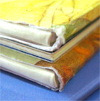|
|
|
|
|
|
|

| 최근 이 책을 구매하신 다른 회원의 책장 |
|
 |
|
|
|
[ 책 소개 ]
"Sarah, Plain and Tall"로 | 닫기x |  What is 뉴베리상? What is 뉴베리상?
Newbery 상은 해마다 미국 도서관 협회(American Library Association)에서 그 해의 가장 뛰어난 어린이 문학책에 수여하는 상이며, 한 작품에 Medal상을, 그리고 2~5편의 작품에 Honor상을 수여합니다. 이 상은 18세기에 영국에서 세계 최초로 아동문학책을 출간하여 상업적으로 성공을 거둔 출판인 John Newbery의 업적을 기리기 위해 1922년에 제정되었으며, 현재는 아동문학 분야의 세계에서 가장 권위있는 상으로 인정받고 있습니다.
|
표현 방법은 달라도 글에서 느껴지는 그 깊은 울림은 어딘가 닮은 데가 있습니다. 이 책은 매클라클랜이 자연과 가족에게 바치는 아름다운 찬가입니다. 이 찬가에서 작가는 조부모와 부모와 아이, 삼대가 사는 농장의 아름다운 풍경들을 어린아이의 목소리를 통해 그림처럼 펼쳐 보입니다.
주인공 엘리는 따뜻한 안식처에서 태어나 엄마, 아빠, 할머니, 할아버지로부터 자연을 사랑하고 그 자연을 소중히 하는 법을 배웁니다. 사슴이 자고 간 자리에 살며시 손을 대 보며 따뜻한 기운을 느끼고, 느릿느릿 기어가는 거북을 보고도 눈이 휘둥그레지는 감수성 풍부한 아이. 시시때때로 변화하는 자연의 미세한 변화들은 느낄 줄 아는 감성을 가진 아이입니다.
엘리가 처음 태어났을 때, 할머니는 엘리를 가슴에 안고 창 밖을 내다 봤습니다. 할머니 품에서 엘리가 처음 들은 것은 바람소리, 그리고 엘리가 처음 본 것은 사랑할 수 밖에 없는 아름다운 계곡과 강, 그리고 블루베리가 자라는 언덕이었습니다. 엘리이 가족은 가장 좋아하는 곳을 갖고 있었습니다만, 엘리는 자라면서 자신이 사랑할 모든 장소는 바로 이곳이라는 것을 깨닫게 되지요...
마치 실사 사진을 찍어 놓은 것 같은 아름다운 세밀화 그림은 감상할만한 가치가 있습니다.
큰 사이즈의 튼튼한 | 닫기x |  What is What is | 닫기x |  What is 하드커버? What is 하드커버?
양장본이라고도 불리우며, 표지가 단단한 판지로 만들어진 책입니다.
판지를 천이나 가죽으로 감싸기도 합니다. 책의 속지는 일반적으로 중성처리된 종이(Acid-free paper)를 사용해서 잘 변질이 되지 않기 때문에 오랫동안 보관하기에 적합합니다. 이 종류의 책은 더스트 재킷, 또는 더스트 커버로 불리는 표지덮개가 함께 있는 경우가 많습니다. 간혹 내부 속지가 콩기름 코팅이 된 경우 고약한 냄새가 나는 책도 있습니다.
|
양장본이라고도 불리우며, 표지가 단단한 판지로 만들어진 책입니다.
판지를 천이나 가죽으로 감싸기도 합니다. 책의 속지는 일반적으로 중성처리된 종이(Acid-free paper)를 사용해서 잘 변질이 되지 않기 때문에 오랫동안 보관하기에 적합합니다. 이 종류의 책은 더스트 재킷, 또는 더스트 커버로 불리는 표지덮개가 함께 있는 경우가 많습니다. 간혹 내부 속지가 콩기름 코팅이 된 경우 고약한 냄새가 나는 책도 있습니다.
|
| 닫기x |  What is 하드커버? What is 하드커버?
양장본이라고도 불리우며, 표지가 단단한 판지로 만들어진 책입니다.
판지를 천이나 가죽으로 감싸기도 합니다. 책의 속지는 일반적으로 중성처리된 종이(Acid-free paper)를 사용해서 잘 변질이 되지 않기 때문에 오랫동안 보관하기에 적합합니다. 이 종류의 책은 더스트 재킷, 또는 더스트 커버로 불리는 표지덮개가 함께 있는 경우가 많습니다. 간혹 내부 속지가 콩기름 코팅이 된 경우 고약한 냄새가 나는 책도 있습니다.
|
[ 서지 정보 ]
Hardcover: 32 pages
ISBN-10: 0060210982
ISBN-13: 978-0060210984
책 크기: 28.5 cm x 23.6 cm
[ 영문 서평 ]
Book Description
Within the sanctuary of a loving family, baby Eli is born and, as he grows, "learns to cherish the people and places around him, eventualy passing on what he has discovered to his new baby sister, Sylvie: 'All the places to love are here . . . no matter where you may live.' This loving book will be something to treasure."'BL."The quiet narrative is so intensely felt it commands attention. . . . a lyrical celebration."
Publishers Weekly
MacLachlan's characteristically resonant language and Wimmer's majestic paintings affectingly celebrate the natural world and the family. Told in the voice of a child who lives on a farm with his parents and grandparents, the author's poetic narrative opens on the day of the boy's birth, when his grandmother holds him up to the open window, "So that what I heard first was the wind. / What I saw first were all the places to love: / The valley, / The river falling down over rocks, / The hilltop where the blueberries grew." The child introduces readers to the spots that each person in his family loves best: for his mother it is the hilltop where the sky is "an arm's length away"; for his grandfather, the dark, cool barn ("Where else, he says, can the soft sound of cows chewing / Make all the difference in the world?"). Only after the birth of his sister does the boy reveal his favorite place of all: the marsh "Where ducklings follow their mother / Like tiny tumbles of leaves." Whether focusing on a single, aging turtle or depicting a sweeping panorama, Wimmer's ( Train Song ; Flight ) paintings beautifully convey the splendor of nature, as well as the deep affection binding three generations. This inspired pairing of words and art is a timeless, uplifting portrait of rural family life.
School Library Journal
"Where else can the soft sound of cows chewing make all the difference in the world?" asks Eli's grandfather about the barn he loves. There are other places on the farm that each family member finds special: the valley, the meadows, the hilltop where the blueberries grow, and the river falling over rocks. As young Eli recounts them simply and warmly, these places become living keepsakes that form a homage to their way of life. The ties of family members to one another and of family to farm are captured in the sweet, pastoral illustrations realistically painted in Norman Rockwellian style. The language has MacLachlan's signature spareness filled with emotion and sensitivity. As in her Three Names (HarperCollins, 1991), the personal reflections are heartwarming and touching. While Eli waits in the barn with his grandfather, the arrival of a new baby reaffirms the continuity of generations as Sylvie's name is added to those carved on a barn rafter. The use of questions such as: "Where else does an old turtle crossing the path make all the difference in the world?" help make the story relevant for young readers. Who else but MacLachlan could carry this off so lovingly. |
|
|
|
|
|
|
|
|